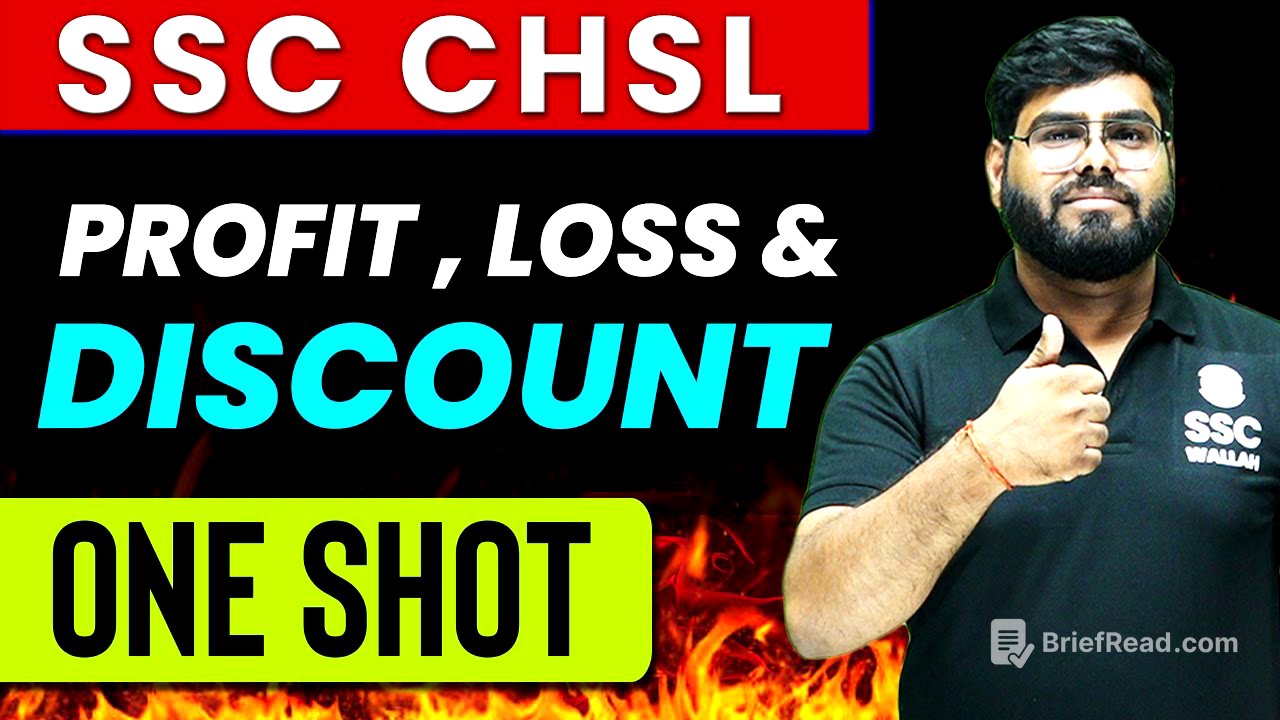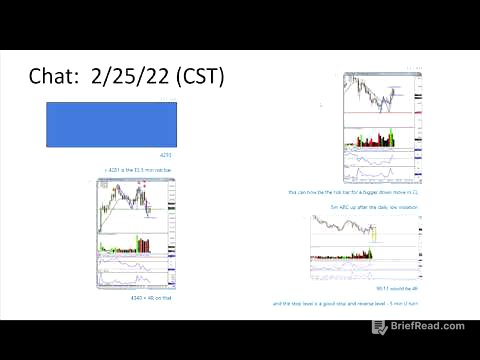TLDR;
This YouTube video by SSC Wallah provides a comprehensive guide to profit, loss, and discount concepts, essential for the SSC CHSL exam. The instructor, Pramod Yadav, explains basic terminology, formulas, and various types of problems, including dishonest dealer scenarios and successive discounts. The lecture emphasizes understanding the underlying concepts rather than rote memorization of formulas and includes numerous examples and practice questions to solidify understanding.
- Basic concepts of Profit, Loss and Discount
- Terminology and Formulas
- Problem Solving Techniques
Introduction [0:32]
Pramod Yadav welcomes viewers to SSC Wallah's online platform and congratulates them on completing the percentage and ratio proportion topics. He stresses the importance of understanding these topics before moving on to profit, loss, and discount. The session will cover basic understanding, question types, dishonest dealers, and previous year questions.
Basic Understanding of Profit and Loss [2:37]
The lecture begins by defining profit and loss in simple terms, relating them to happiness (profit) and sadness (loss) in daily life. An example is given where person A buys a phone for ₹12000 and sells it to person B for ₹10000, resulting in a loss. Conversely, if A sells the phone for ₹13000, it results in a profit. The concepts of cost price (CP) and selling price (SP) are introduced.
Cost Price and Selling Price [13:02]
Cost price is defined as the price at which an item is bought, while selling price is the price at which it is sold. If the selling price is higher than the cost price, there is a profit; if it's lower, there is a loss. Formulas for calculating loss (CP - SP) and profit (SP - CP) are provided. The lecture also explains how the cost price for one person can be the selling price for another in a transaction chain.
Percentage Change and Profit/Loss Calculation [19:03]
The concept of percentage change is reviewed, emphasizing that it is always calculated on the initial value. In the context of profit and loss, the initial value is the cost price. The lecture clarifies that profit or loss percentage is generally calculated on the cost price unless explicitly stated otherwise.
Formulas for Loss and Profit Percentage [22:56]
The formulas for calculating loss percentage (Loss / CP * 100) and profit percentage (Profit / CP * 100) are reiterated. The importance of understanding these terms is emphasized over simply memorizing the formulas.
Understanding Discount [26:06]
The concept of discount is introduced through an example of two shoe stores, one offering a 50% discount on a ₹3000 pair of shoes and another selling the same pair for ₹1200 with no discount. The lecture explains that discounts are used to attract customers and increase sales.
Markup and MRP [29:31]
To offer a discount, sellers often increase the price of an item first. This increase is called "markup." The marked-up price is known as the Maximum Retail Price (MRP), or the face value. The discount is then applied to the MRP to determine the selling price.
Markup and Discount Percentage [34:41]
Markup percentage is calculated on the cost price, while discount percentage is calculated on the MRP. The formulas for markup (MRP - CP) and discount (MRP - SP) are provided. The lecture stresses the importance of remembering these base values for accurate calculations.
Relationship Between Cost Price, Selling Price and MRP [37:48]
The relationship between cost price, selling price, MRP, markup, and discount is further explained. The instructor emphasizes that understanding these relationships is crucial for solving problems related to profit, loss, and discount.
Four Important Percentages [44:08]
The four key percentages in profit, loss, and discount calculations are profit percentage, loss percentage, markup percentage, and discount percentage. The lecture explains how to convert these percentages into fractions and use them to find ratios between CP and SP, or MRP and SP.
Profit Calculation on Selling Price [51:19]
The lecture addresses scenarios where profit is calculated on the selling price instead of the cost price. It emphasizes that the actual profit should always be calculated on the cost price. Examples are provided to illustrate how to calculate actual profit percentage when the profit percentage on the selling price is given.
Equal Profit and Loss [57:43]
When the profit from selling an item once and the loss from selling it another time are equal, the cost price is the average of the two selling prices. The formula for this scenario is given as CP = (SP1 + SP2) / 2.
Practice Questions [59:30]
The session transitions to solving practice questions related to profit, loss, and discount. Various types of problems are tackled, including those involving cost price, selling price, profit percentage, loss percentage, and dishonest dealers.
Article and Price Related Questions [1:52:33]
The lecture moves on to questions related to articles and prices, emphasizing the importance of equating the number of articles when comparing different transactions. Several examples are worked through to illustrate this concept.
Dishonest Dealer Problems [3:21:15]
The concept of dishonest dealers is explained, focusing on how they manipulate weights and measures to increase profits. The lecture explains how to calculate profit percentage in such scenarios, emphasizing that the dishonest dealer always benefits.
Successive Processes with Dishonest Dealers [3:30:33]
The lecture explains how to apply the successive process to problems involving dishonest dealers. It emphasizes that the initial value is always lower, and the final value is always higher in these scenarios.
Discount Related Questions [3:47:11]
The session transitions to solving practice questions related to discounts. Various types of problems are tackled, including those involving successive discounts and finding single equivalent discounts.









